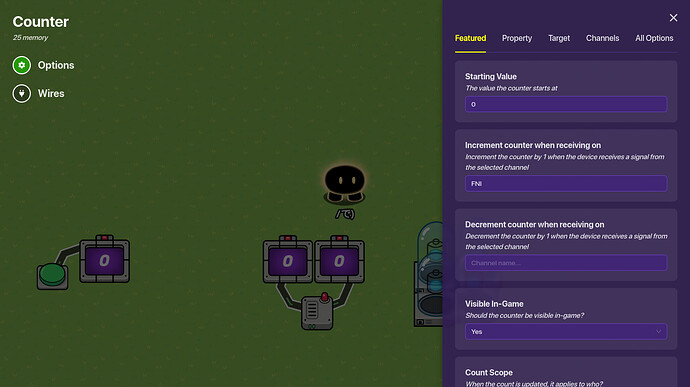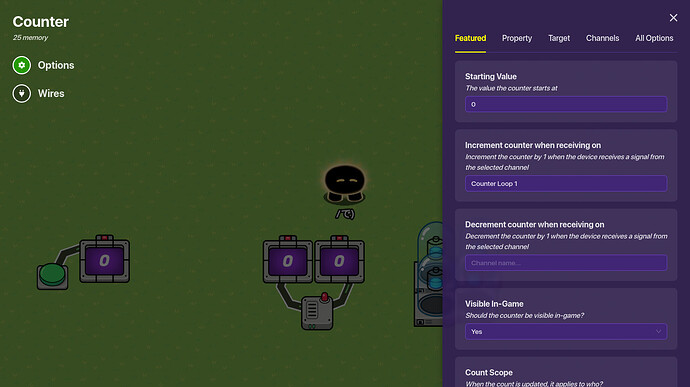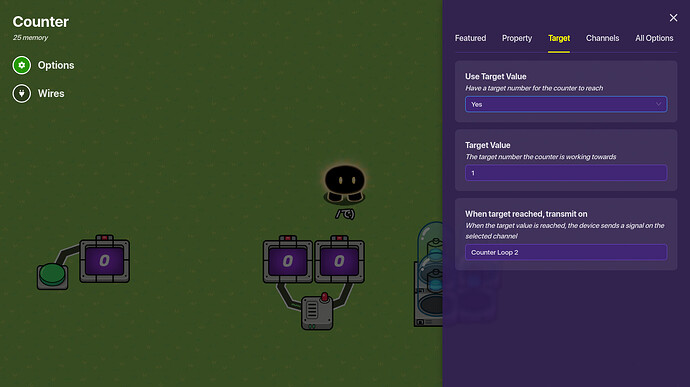In my original guide (How to use Non-Items), I covered multiple methods, although I never made a very good explanation as to how to make them do anything. Before I explain, however, I will refer to three kinds of Non-Items: Materials (used to obtain other Non-Items), Checks (used to disable or enable something), and FNI (Short for Functional Non-Item, these are basically the “other” category). Also, in case it wasn’t clear, a Non-Item is an item that is not in GKC and only creates the illusion of having it. They themselves serve no purpose other then to name the buttons on the floor that you have to press to press another button to get through a door.
General
The best way to use Non-Items is by having an invisible button that acts as that Non-Item. For example, there can be an Arcade Machine that will give you Arcade Tokens. It won’t actually, but by using a counter you can store a number that is the number of Arcade Tokens you have. Also, If you want the Arcade Machine to give you, say, 10 tokens, you could have a repeater that repeats the signal to increment the counter ten times.
Next, I will go over how to use them.
Materials
The main way to use materials is with the counter method mentioned in the ‘General’ tab. Then, when it gets to the number you want, it transmits a signal enabling a button which will send a signal and pretend to give you another Non-Item. At this time, you will also likely disable the button and reset the counter, but depending on the scenario, you may want to decrease by the required amount instead (By decreasing instead of increasing with the method in the ‘General’ tab for more than one increment)
Checks
A Check allows you to do something. The Arcade Machine example is an example of how to get Non-Items, but what if it needed to be turned on first? What if you needed to find the cable to plug it in? Thankfully, this is rather easy to accomplish. The cable itself would be a Check. However you obtain it doesn’t matter, what matters is that when you obtain it, it activates a button that will send a signal to activate a button to “play” the Arcade Machine to “get” Arcade Tokens and “win” the “prize”. Another example is chopping trees to obtain Wood. Each tree is a decoration with an invisible button by it that sends a signal to increase the counter and hide the tree. Then, once you get the correct amount of Wood, the counter will send a signal that will activate a button. Pressing this button will send a signal to hide a barrier on the river to let you pass right through.
FNI
There is a very real chance you skipped right here because you wanted to know how something without any functions can be functional, aside from activating a button. This may seem confusing, but it comes down to using multiple counters for the same Non-Item. For example, the FNI is obtained, sending a signal to a counter, which reaches the target value of 1 and resets itself while incrementing another counter which reaches its target value, resetting it and, through a wire repeater set to a .1 second delay, increments the first counter, creating a Counter Loop. Counter loops are incredibly useful and I personally think activating a Counter Loop is more like a lasting buff rather than the kind of thing a Check would be used for.
Finally, I will go over how to use them with actual items. There are actually two kinds. Inputs and Outputs.
Inputs
Inputs are when you use actual items to obtain Non-Items. This is possible by using vending machines that send a signal to say you have that Non-Item. Example: You use 5 Dynamic Silver to make a bucket.
Outputs
Outputs are the opposite of inputs. However. there are two kinds of outputs:
Permanent
Permanent Outputs allow you to get an item as many times as you want once you get the required Non-Item. This is rather simple to make, as once the button (or whatever you are using) is active, it will never get disabled. Example: Once you obtain the bucket, you can keep getting water as much as you want.
Limited
One time use Output Non-Items are easy to make; just make the button deactivate with the same signal it sends when it is pressed. For more than one use, but still limited, you can use a counter that decrements whenever the button is pressed, and when it reaches zero the button is disabled. Example: You can use the bucket to collect water, but if you use it three times it breaks and you can’t use it anymore.
- 0/10
- 1/10
- 2/10
- 3/10
- 4/10
- 5/10
- 6/10
- 7/10
- 8/10
- 9/10
- 10/10
- 11/10
- 50/20
- 0/10
- 1/10
- 2/10
- 3/10
- 4/10
- 5/10
- 6/10
- 7/10
- 8/10
- 9/10
- 10/10
- 11/10
- 50/20
- 0/10
- 1/10
- 2/10
- 3/10
- 4/10
- 5/10
- 6/10
- 7/10
- 8/10
- 9/10
- 10/10
- 11/10
- 50/20









